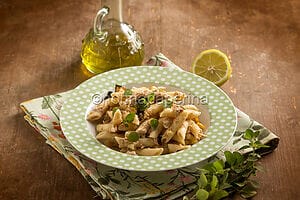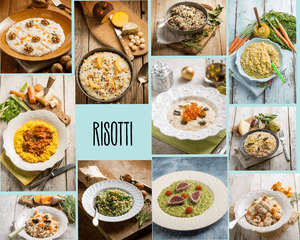Mushrooms

Mushrooms, a delicious but demanding veggie
The topic of mushrooms is so vast that it cannot be covered in one article. This is also due to the fact that mushrooms represent one of the “kingdoms” of the living world. However, focusing on edible ones, we can list some main characteristics. For example, unlike plant species, they do not contain sap. Furthermore, they reproduce through spores rather than through embryonic stages (as happens with animals and plants).
As everyone is aware, mushrooms can be extremely dangerous; therefore, you should be extremely cautious when handling them, particularly if you gather them yourself. Totally edible ones have a unique nutritional profile: they have a lot of mineral salts but are devoid of all proteins, carbs, and vitamins. Although the amounts vary from variety to variety, manganese, iron, and calcium are often highly prevalent. Furthermore, folates are also very present.
The most consumed mushrooms
There are hundreds of varieties of edible mushrooms. Below, I list the most consumed ones in Italy:
- Porcini They need no introduction; the flesh is almost white, it has a firm consistency, and it also has a strong aroma. They are among the most versatile in the kitchen.
- Flat-Cap Mushrooms. The cap is large and flattened, and they also have tender flesh that is suitable for frying. The colour ranges from white to brown.
- Button Mushrooms. They contain the highest amount of fibre when it comes to mushrooms. They are widely available, which makes them inexpensive, and most importantly, their flavour is excellent.
- Chiodini Mushrooms. With a medium consistency and crunchiness, these mushrooms are recognisable by their characteristic tack shape.
- Chanterelle Mushrooms. These mushrooms have a characteristic wavy crown and a tough, fibrous pulp. They are best eaten in a pan as a side dish or as an appetiser.
- Truffles. This is a very valuable variety; it is characterised by its tender, tasty pulp and a strong aroma.
Mushrooms in the kitchen
In addition to their delicious flavour, mushrooms are valued for their extraordinary adaptability. They can take the stage with a plethora of different dishes. Their traditional and “simple” use is to briefly stir-fry them in a pan to make a tasty appetiser or side dish.
They go well with both pasta – and rice- based first dishes (mushroom risottos are a classic combination). They can also be cooked in bread crumbs. Additionally, mushrooms can be found in first courses that are especially soupy, as in some Asian cuisines. The cleaning process is highly important, in part because they are often packed with dirt and may contain parts that are not edible.
How to cook a mushroom-based first course
After having introduced the main methods of cooking mushrooms, I will now describe some of my favourite recipes. Let’s start with the first courses, which feature not only rice but also pasta. However, I advise you to delve deeper into the detailed recipes you find on the site.
Baked gnocchi with mushrooms. This dish is proof that mushrooms lend themselves to very complex recipes that involve numerous ingredients. In this dish, we also find potatoes and beets; these ingredients form a pleasant symphony of colours and flavours.
Pumpkin gnocchi with mushroom sauce. For this recipe, you can use porcini mushrooms, button mushrooms, or a selection that includes more varieties. The result is always the same: a light and creamy first course with a vibrant hue.
Spaghetti with pheasant ragu and porcini mushrooms. In this case, the tasty and aromatic pheasant meat goes perfectly with the delicacy of the mushrooms. While the preparation is classic, the mixture is innovative.
Corzetti pasta with porcini mushrooms. This recipe is very simple to prepare, but it offers a lot in terms of aesthetics and taste. It has a great garnish of toasted pine nuts, which enhances its variable texture and blends of delicate and composite flavours.
Some interesting side dish recipes
Mushrooms are also suitable for the preparation of side dishes, which are full-bodied and offer a sometimes complex flavour. Here are some interesting ideas:
Stewed venison with mushrooms. It is a second course with a mushroom-based side dish, which, for this recipe, is sautéed in a pan with oil, garlic, and leeks. The best variety for this recipe is the porcini mushroom, which, with its delicacy, contrasts with the aromatic flavour of the deer meat.
Pan-fried mushrooms with tomatoes. It is a very nice-looking side dish that can also be considered an appetizer. It involves cooking the tomatoes, marinated with Tabasco, together with the mushrooms. The latter must be placed on top as a garnish. The recipe also features bacon and cottage cheese, so it is quite full-bodied.
Porcini mushroom and nasturtium flower salad. It is a very light side dish that is based on a delicate combination of flavours and colours. The aromatic notes of the porcini mushroom blend perfectly with the delicate floral scents. There’s also a great contrast between the vibrant tones of the nasturtium and the more subdued hues of the mushroom.
What are the benefits of mushrooms?
I have already discussed the nutritional qualities and biochemical makeup of mushrooms. Now is the time to look into the advantages it provides for the body. After accounting for the safety measures implemented in advance, the advantages are significant.
For starters, mushrooms help prevent cancer by slowing down cellular ageing and fighting free radicals. The reason for this lies in the supply of antioxidants such as lysine and tryptophan (which vary from variety to variety).
Another benefit consists of the remineralizing capacity of mushrooms, which supports the body and the immune system. Between calcium, magnesium, and partly potassium, this vegetable contributes to a perfectly balanced diet. It should be emphasised once more that mushrooms can aid in weight loss without causing excessive hunger because they are often low in calories.
Does mushroom intolerance exist?
Basically, we should discuss allergies instead of intolerance. The problem is complicated in part because there are numerous macro-types, or kinds, of allergies to mushrooms rather than “just one.” However, allergies to porcini mushrooms are the most common.
Mind you, the issue does not concern the traditional distinction between edible and non-edible varieties; the latter cause serious disorders that lead to intoxication.
Mushroom allergy, on the other hand, produces symptoms that are completely comparable to those of other allergies. They range from systemic to dermatological disorders such as urticaria, angioedema, conjunctivitis, and dermatitis, up to gastrointestinal disorders such as diarrhoea and nausea. In the worst-case scenario, you could have a severe headache, respiratory distress, or anaphylactic shock.
Some contraindications to keep in mind
The issue of contraindications connected to mushrooms is different; in this case, some categories of people should avoid consuming them or limit their intake to small quantities. The reference is in particular to pregnant or breastfeeding women, given that the active ingredients of the mushrooms could be too “heavy” for the little one.
For this same reason, they are not recommended for those suffering from kidney stones, gout, or circulatory system problems. Some varieties, in fact, increase the blood pressure.
Naturally, all of the recommendations for choosing mushrooms correctly still hold true, and doing so requires the assistance of industry specialists. Certain toxic kinds might be deceiving because they resemble edible varieties in size and appearance.
The most common FAQs:
How are mushrooms classified?
Of course, the primary differentiation to be made is between edible and toxic types, but there are also a lot of other more technical selection factors. As an illustration, consider the saprophytic fungus, which “relies” on other living things for sustenance. Furthermore, we find “symbiotic” fungi, which interact on an equal basis with other organisms without having a parasitic value. Grifola and Pioppino belong to the first category. The second category, however, includes amanitas, russulas, and laccarie.
What diseases do mushrooms cause?
If you can call it that, food poisoning is the most common ailment that mushrooms cause. At first, the symptoms are gastrointestinal, but they can progress to potentially fatal dehydration. When taken in significant quantities, certain edible species may also cause hallucinations.
What health benefits might mushrooms offer?
When eaten in moderation, mushrooms serve as antioxidants and remineralizers. As a result, they boost our body’s potential, fortify the immune system, and aid in the prevention of cancer. It should be noted that the benefits of vitamin D for immune systems differ significantly across species. Finally, they also help you lose weight, as they are low-calorie and restore a sense of satiety.




















